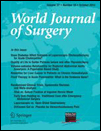The Prognostic Relevance of Psammoma Bodies and Ultrasonographic Intratumoral Calcifications in Papillary Thyroid Carcinoma
Jung-Soo Pyo and Guhyun Kang contributed equally to this study.
Abstract
Background
Although psammoma bodies (PB) are found in up to 50 % of papillary thyroid carcinomas (PTC), their clinicopathological significance remains uncertain. The aim of the present study was to determine the clinicopathological significance of PB and the correlation between PB and ultrasonographic intratumoral calcification in PTC.
Methods
The clinicopathological parameters, ultrasonographic calcifications, and the presence of PB were evaluated in 258 surgically resected conventional PTC.
Results
Psammoma bodies were found in 141 of 258 PTC (54.7 %). The presence of PB was significantly correlated with tumor multifocality, extrathyroidal extension, and lymph node metastasis (P = 0.009, P = 0.004, and P < 0.001, respectively), but not with the BRAFV600E mutation. Higher incidences of both intratumoral and extratumoral PB were found in overt PTC (>1 cm) than in papillary microcarcinomas (≤1 cm) (P < 0.001 and P = 0.015, respectively). Extratumoral PB were only identified in 48.9 % of 141 PTC with PB, and PTC with extratumoral PB showed higher incidences of tumor multifocality, extrathyroidal extension, and nodal metastasis compared to PTC with intratumoral PB (P = 0.014, P = 0.005 and P = 0.001, respectively). Ultrasonographic intratumoral calcification corresponded to clusters of intratumoral PB (P < 0.001) and was associated with nodal metastasis (P = 0.026).
Conclusions
The findings of the present study suggest that the presence of PB may be a useful prognostic indicator of aggressive PTC behaviors. In addition, confirmation of ultrasonographic intratumoral calcification would be a useful decision-making criterion when determining the need for preoperative or intraoperative surveillance of nodal metastasis.




